Te has preguntado alguna vez que tan profundo es el mar ? Aunque el fondo del océano no es plano, el lugar más profundo documentado es de 11.033 metros.
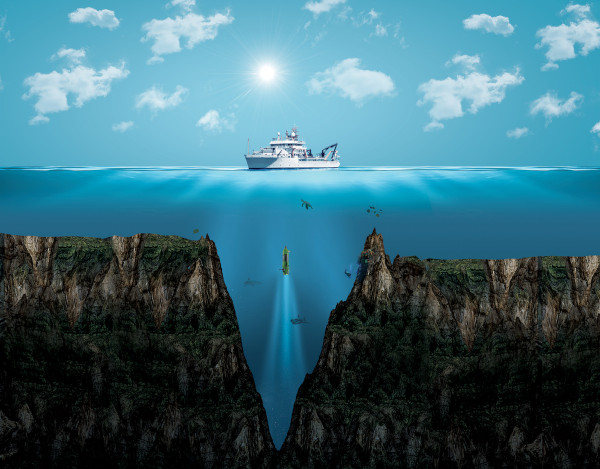
Esta increíble animación de Tech Insider muestra la profundidad del mar en una forma muy precisa. El video utiliza comparaciones para comprender mejor las dimensiones. Dale una mirada!
Los océanos cubren el 71% de la superficie de la tierra. El más grande de ellos es el Océano Pacífico con una profundidad promedio de 3730 metros. Pero, te has preguntado cual será la mayor profundidad conocida del mar ?
Los productores del video dicen «Esta animación pone la distancia real en perspectiva, mostrando la enorme distancia entre las olas que vemos y el punto más profundo conocido como el «Challenger Deep» o el «Abismo Callenger»
Cuál es el lugar más profundo del océano ?
Cerca de la isla de Guam al norte de las Filipinas, se ubica la fosa de las Marianas. Este lugar tiene una profundidad documentada de 11,033 metros y es conocido como el lugar más profundo del océano.
La fosa también tiene un largo de 2,542 metros, lo que la convierte en una de las más grandes en el planeta.
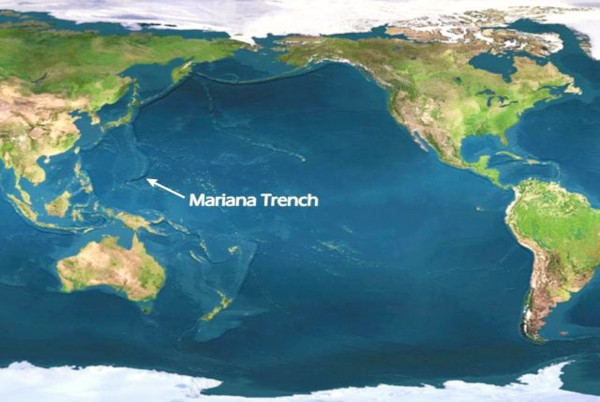
Para tener una mejor idea de que tan profunda es la fosa de las Marianas, basta con notar que sus 11 kilometros por debajo de la superficie marina, excede en 2000 metros la altura del Monte Everest, que es la elevación más alta sobre la tierra.
El fondo marino es tan complejo e interesante como la geografía terrestre. En el fondo del océano encontramos montes, valles, llanuras, cadenas montañosas y volcanes activos. La erupción de un volcán submarino es uno de los fenómenos más interesantes e impresionantes de la tierra.
¿Qué es el Abismo Challenger?
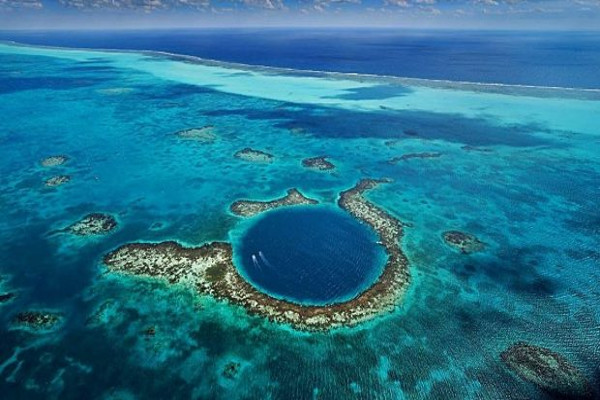
El Challenger Deep es el punto más bajo de la corteza terrestre y el mismo está ubicado dentro de la ya profunda Fosa de las Marianas, en el Océano Pacífico occidental.
La profundidad real de Challenger Deep pone a prueba la imaginación. La ubicación es en el extremo sur de la Fosa de las Marianas.
Tiene alrededor de 11.000 metros de profundidad y se lo conoce con ese nombre porque, el HMS Challenger fue la embarcación de donde se hizo el primer sondeo de las profundidades de esta fosa, en el año 1875.
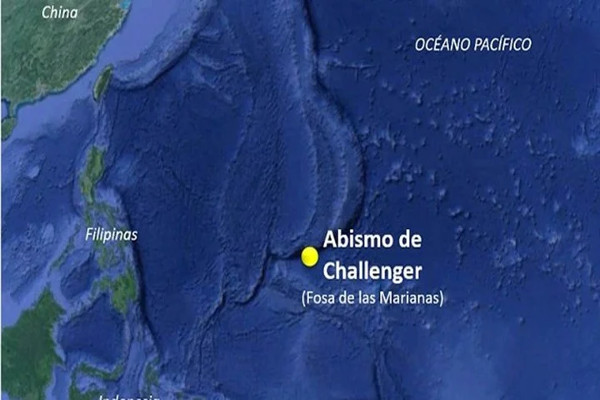
Los 5 puntos más profundos del océano
Aunque la Fosa de las Marianas sigue siendo el punto más profundo del océano, en realidad no es el único. Una expedición organizada en 2018 por un grupo de científicos en una misión llamada Five Deeps Expedition, confirmó los 5 puntos más profundos del océano. Los resultados de la investigación fueron publicados en la revista científica Geoscience Data Journal y los resumimos aquí.
| Rank | Trench Name | Deep Name | Depth in meters | Depth in Feets | Ocean |
| 1 | Mariana Trench | Challenger Deep | 10924 | 35840 | Pacific Ocean |
| 2 | Puerto Rico Trench | Browson Deep | 8378 | 27487 | Atlantic Ocean |
| 3 | South Sandwich Trench | Factorian Deep | 7432 | 24383 | Southern Ocean |
| 4 | Java Trench | Unnamed | 7187 | 23579 | Indian Ocean |
| 5 | Unnamed | Molloy Hole | 5581 | 18310 | Artic Ocean |
Ballena Azul alimentándose a 330 pies de profundidad
Las ballenas azules suelen cazar a profundidades de alrededor de 330 pies dentro una zona bien iluminada del océano.
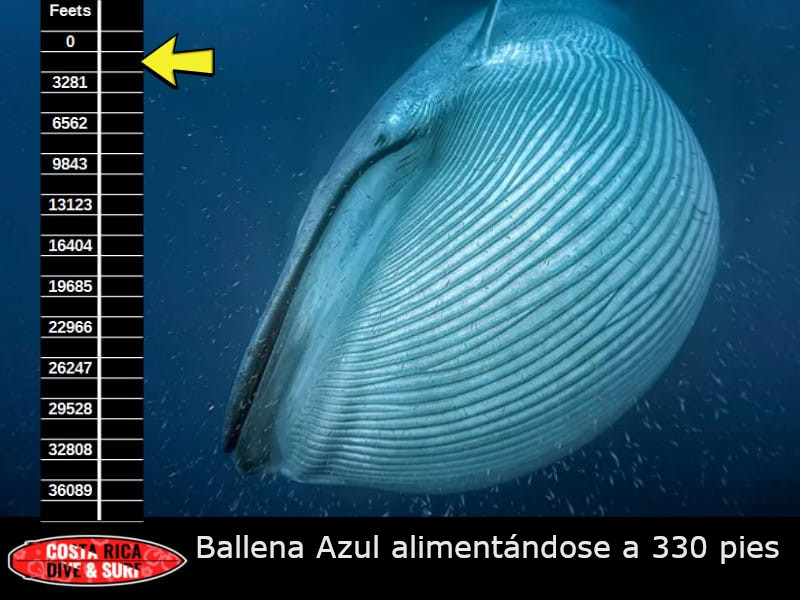
Submarino Tritón a 700 pies
A 700 pies, el US Tritón se convirtió en el primer submarino en navegar alrededor de la Tierra en 1960.
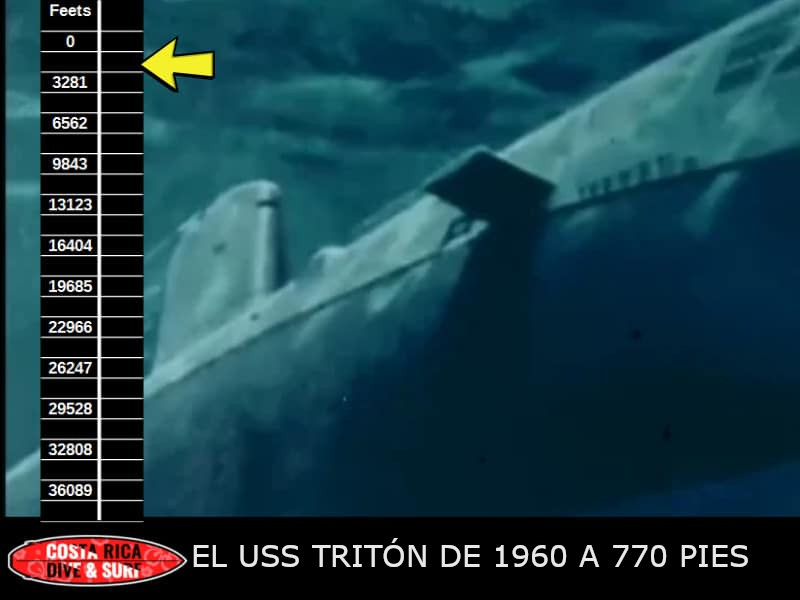
La inmersión libre más profunda de la historia: Profundidad del océano: 831 pies
A 831 pies, alcanzamos la inmersión libre más profunda de la historia registrada.
Aquí abajo, la presión es 26 veces mayor que en la superficie, lo que dañaría a la mayoría de los pulmones humanos.
Pero las ballenas lo logran, sumergiéndose a una profundidad máxima de 1640 pies, lugar en donde cazan y se alimentan de calamares gigantes.
Zona de peligro para submarinos: Profundidad del océano: 2400 pies
A 2400 pies, llegamos a la zona de peligro para los modernos submarinos de ataque nuclear, más profundo el casco del submarino colapsaría.
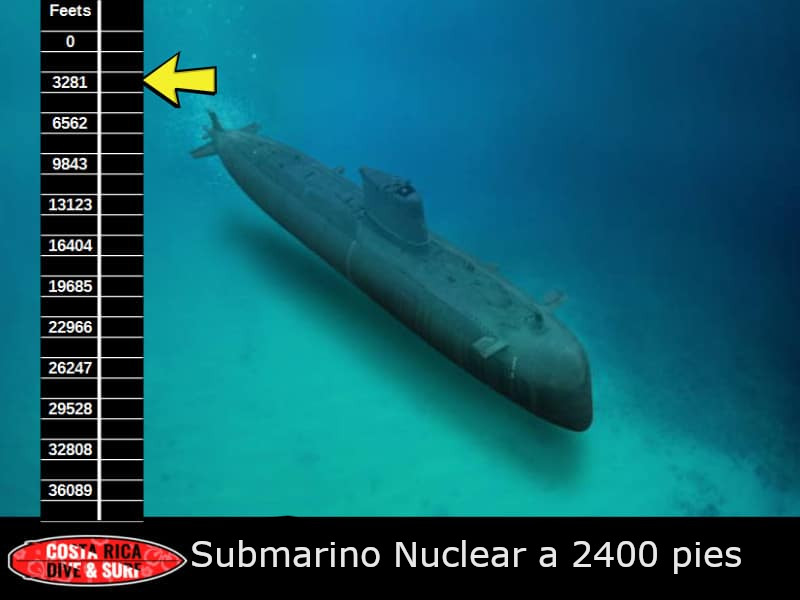
Burj Khalifa-Profundidad del océano: 2722 pies
A 2722 pies hacia abajo es donde llegaría la punta del edificio más alto del mundo, el Burj Khalifa.
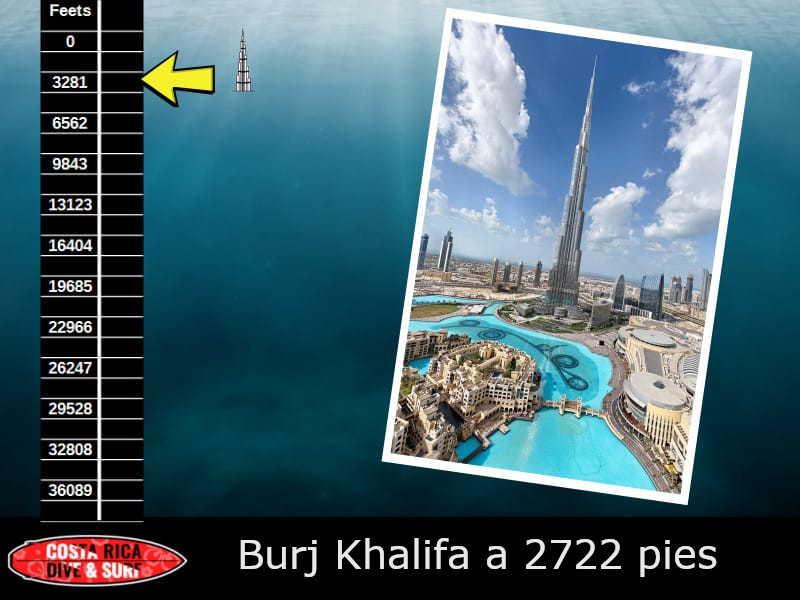
Sin luz solar-Profundidad del océano: 3280 pies
Un poco más lejos, a 3280 pies, estamos lo suficientemente sumergidos como para que la luz del sol no nos alcance.
Ahora hemos entrado a “La zona de medianoche.”
La zona de Media Noche
Muchos animales allí abajo no pueden ver, como los camarones sin ojos a 7500 pies que habitan cerca de volcanes ardientes.
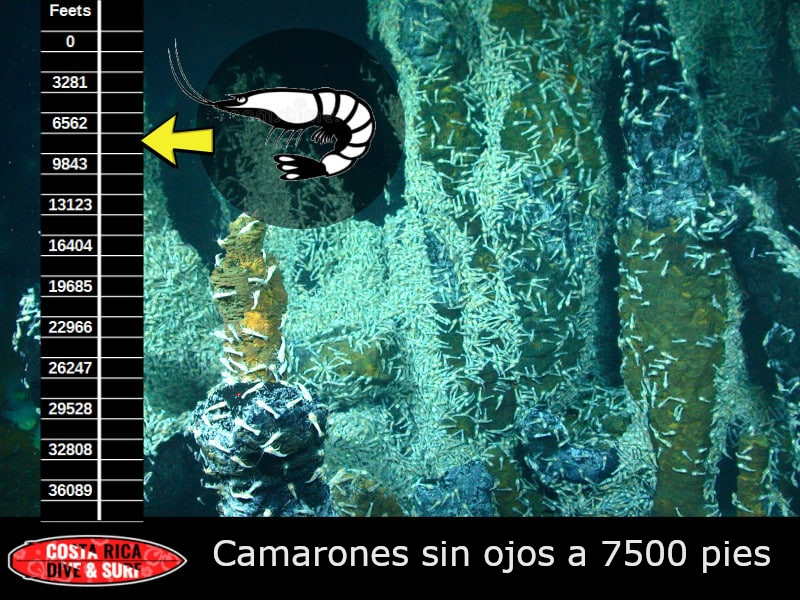
A esta profundidad, las temperaturas están solo unos pocos grados por encima del punto de congelación, pero las aguas alrededor de los respiraderos hidrotermales pueden calentarse hasta 800 grados F°
La profundidad máxima que se ha registrado la inmersión de un mamífero es a 9816 pies. La ballena picuda Cuvier.
Pero ni siquiera el Zifio de Cuvier pudo explorar el RMS Titanic, que descansa a una asombrosa profundidad de 12500 pies.
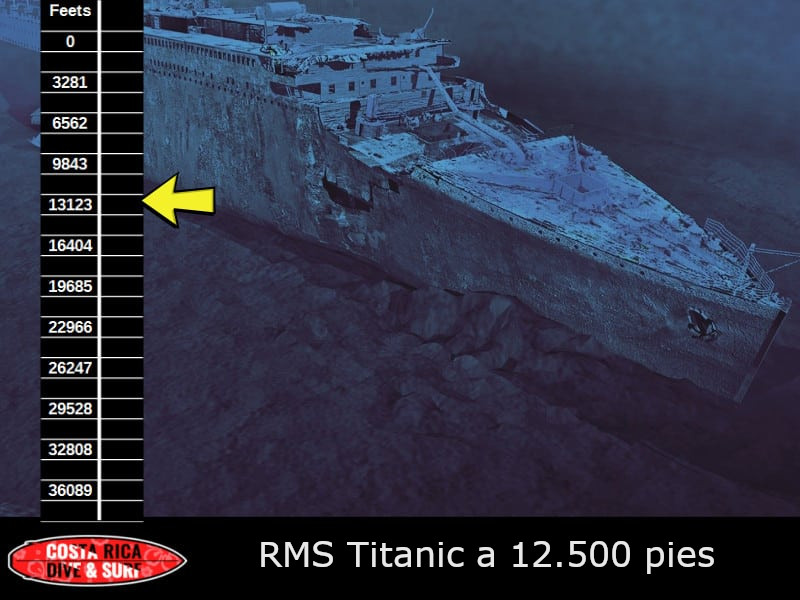
La presión en ese lugar es de 378 veces mayor que en la superficie.
Sin embargo, todavía se puede encontrar vida marina como el colmillo, pez bruja y el pulpo Dumbo, el pulp cuyo habitad es el más profundo de la Tierra.
La Zona Hadal-Profundidad del océano: 20.000 pies
A 20.000 pies está la Zona Hadal, un área designada para las trincheras más profundas de los océanos, como la Fosa de las Marianas.
Si sumergiéramos al Monte Everest hacia la Fosa de las Marianas, su cumbre alcanzaría los 29029 pies.
Eso todavía no se compara con las dos misiones tripuladas más profundas de la historia.
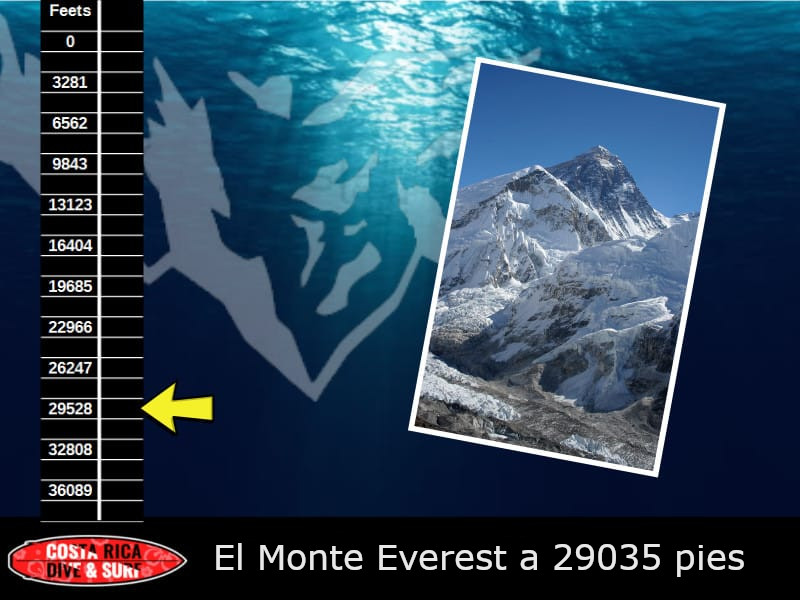
La conquista de James Cameron- Profundidad del océano: 35.756 pies
En 2012, el director James Cameron descendió a 35.756 pies para la Deep Sea Challenger Mission, pero los científicos estiman que hay potencialmente miles de especies marinas que aún no hemos descubierto.

Los seres humanos han explorado un estimado del 5 al 10% de los océanos de la Tierra.
Recién hemos comenzado a comprender el mundo profundo y oscuro que fluye debajo de nosotros.
Jacques Piccard y Don Walsh-Profundidad del océano: 35.797 pies
Pero Cameron no rompió el récord, que fue establecido por el oceanógrafo Jacques Piccard y el teniente Don Walsh en 1960.
Piccard y Walsh descendieron al punto más bajo de la Tierra, Challenger Deep, a un récord de 35,797 pies debajo de la superficie.
Desde entonces, los científicos han enviado media docena de sumergibles no tripulados para explorar Challenger Deep, incluido Kaiko, que recolectó más de 350 especies del lecho marino entre 1995-2003.
¿Hay vida en el fondo de las profundidades marinas?
En el fondo del mar, la temperatura del agua es baja debido a la dispersión de la energía solar. A 3,000 metros la luz solar desaparece completamente, así que imagina lo oscura que debe ser la fosa de las Marianas.
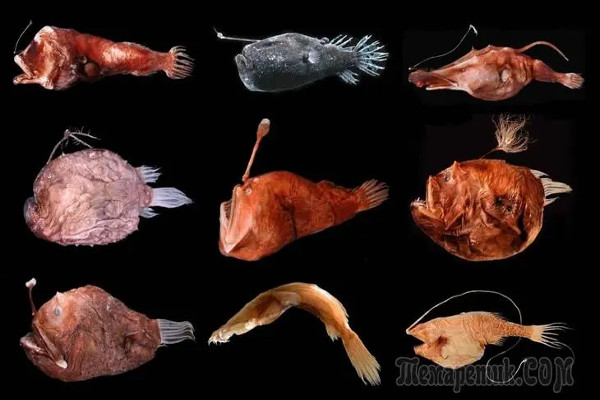
A esas profundidades, debido a la falta de luz y calor, combinado con la enorme presión del agua, la evolución y desarrollo de la vida parece ser imposible.
Sin embargo, hay evidencia de que existe vida y que ha evolucionado exitosamente.
La mayoría de los animales de estas profundidades no tienen ojos. Además, la densidad de sus cuerpos es muy baja para contrarrestar la presión de la masa de agua.
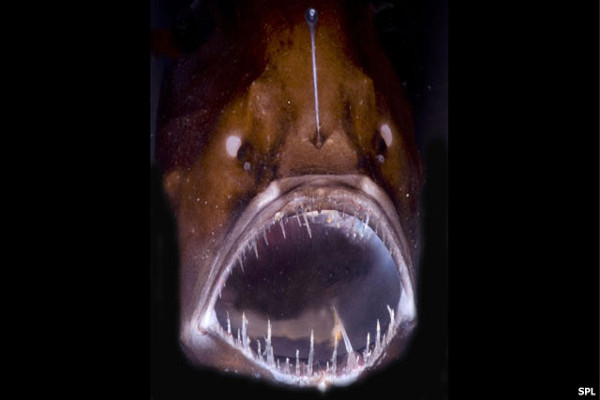
¿Qué otros animales viven en las zonas más profundas?
Aún cuando la fosa de las Marianas es imperiosamente profundo, no podemos descartar que puedan existir lugar más profundos.
El nivel de presión allí es de 110 Megapascales, el equivalente a 1.000.000 pascales.
Ningún animal de la superficie podría soportar este tipo de presión.
En estas zonas viven bacterias que viven gracias a metabolizar el hidrógeno y el metano que son liberados por las rocas y el agua.
Estos son algunas de las especies:
- Anfípodos hadales 10,320 metros
- Pez brótula 8360 metros
- Pez Pseudoliparis amblystomopsis 8175 metros
- Ctenóforos 7215 metros
- Poliplacóforos o cochinillas de mar 6895 metros
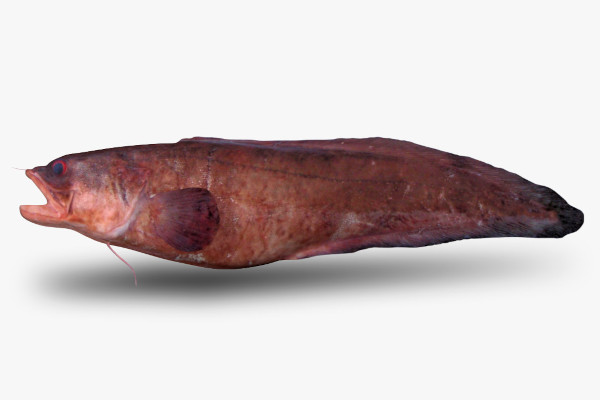
¿Porqué el hombre no puede llegar al fondo del mar?
Ya hemos respondido a nuestra pregunta de: ¿Qué tan profundo es el mar?
Ahora, ¿porqué el hombre no puede llegar al fondo del mismo?
La razón principal es la intensa presión sobre el fondo del océano, lo cual hace que el entorno sea muy difícil de explorar.
La presión del aire que empuja hacia abajo nuestro cuerpo al nivel del mar es alrededor de cien mil Newton por metro cuadrado.
La anatomía del ser humano está hecha para vivir cómodamente en un entorno terrestre. Esto se debe a su evolución bajo ciertas condiciones, lo cual nos hace depender del oxigeno.
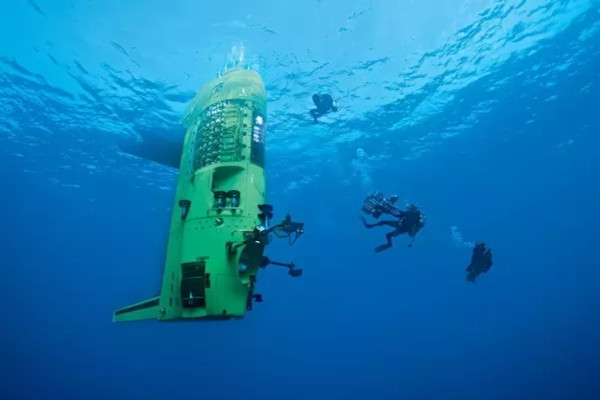
¿A qué profundidad se puede llegar durante el buceo?
Profundidad en el buceo recreativo
Lo máximo recomendado es alrededor de 18 metros de profundidad aproximadamente, durante el buceo recreativo. Los límites de descompresión van hasta los cuarenta metros.
Es decir, después de esta profundidad, es obligatorio hacer paradas de descompresión.
En realidad este es un tema bastante debatido aún en los foros de buceo. Dado que existen otros factores que se deben tener en cuenta a la hora
de definir a qué profundidad pueden los nuevos buzos sumergirse.
Profundidad en el buceo técnico
Los buzos en el buceo técnico sí pueden llegar a una profundidad de más de cuarenta metros. Siempre y cuando hagan las paradas obligatorias de descompresión.
Si te gustaría obtener más información de que tan profundo es el mar, revisa estos artículos en inglés. o envíanos un mensaje si deseas más información sobre vida marina o scuba diving.
Conclusión
Observando los misterios de las profundidades del océano, la fascinante animación que se muestra en este artículo nos lleva a un viaje cautivador.
Desde la impresionante Fosa de las Marianas hasta el enigmático Abismo Challenger, hemos desentrañado los secretos escondidos bajo las olas.
A través de la exploración y la tecnología de punta, la humanidad continúa sondeando las increíbles profundidades de los océanos de nuestro planeta, revelando la resiliencia de la vida incluso en los entornos más hostiles.
Esta exploración no sólo amplía nuestro conocimiento sino que también enfatiza la importancia de preservar estas maravillas, asegurando que la belleza y la complejidad de las profundidades del océano perduren para las generaciones venideras.
